This comprehensive guide explores the evolution of art from prehistoric times to the present, offering insights into major movements, styles, and influential artists across centuries.
Overview of the Timeline Structure
The timeline is divided into major periods, from Prehistoric Art (30,000 BC – 3000 BC) to Contemporary Art (late 20th century – present). Each section highlights key movements, styles, and influential artists, providing a chronological framework to trace artistic evolution. The structure emphasizes transitions between periods, such as the shift from Romanesque to Gothic or the emergence of Renaissance ideals. By organizing art history into distinct eras, the timeline offers a clear progression of ideas, techniques, and cultural influences shaping global artistic expression.
Importance of Understanding Art History
Understanding art history is essential for appreciating the cultural, social, and intellectual development of civilizations. It provides insight into the evolution of artistic expression, reflecting societal values and technological advancements. By studying art history, we gain a deeper understanding of past cultures and their contributions to modern creativity. This knowledge enriches our appreciation of art and its role in shaping human identity across time and place, while also highlighting recurring themes and influences that continue to inspire contemporary artists.
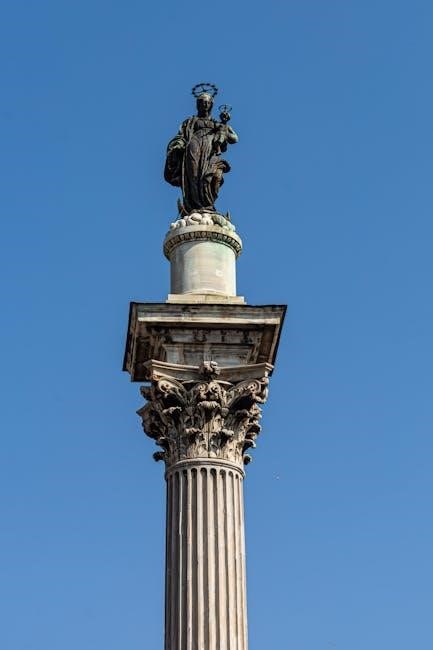
Prehistoric Art (30,000 BC – 3000 BC)
Prehistoric art spans from cave paintings to early sculptures, reflecting human evolution and cultural development through symbolic expressions and tools, marking the dawn of artistic expression.
Paleolithic Art (Up to 10,000 BC)
Paleolithic art emerged during the Stone Age, featuring cave paintings, carvings, and sculptures. Notable works include Lascaux cave paintings in France, depicting animals and humans. Early humans used primitive tools to create these artworks, often for ritual or communicative purposes. This period laid the foundation for artistic expression, showcasing early humanity’s connection to nature and spirituality. The art reflects the daily life and beliefs of early societies, marking the beginning of recorded artistic endeavors.
Mesolithic and Neolithic Art (10,000 BC – 3000 BC)
The Mesolithic period saw the rise of smaller, more intricate sculptures and cave paintings, reflecting a shift toward settled communities. Neolithic art emerged with the development of agriculture, featuring pottery, weaving, and monumental structures like megaliths. This era marked the transition from nomadic to agrarian lifestyles, with art often symbolizing spiritual and cultural practices. Tools and decorative items crafted from stone, bone, and clay highlighted human ingenuity and the beginning of more complex societal structures.
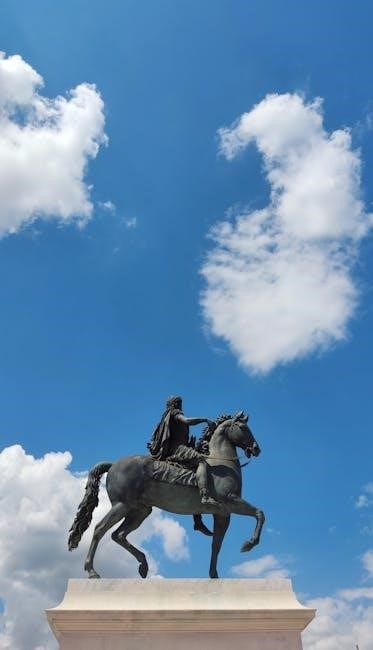
Ancient Egyptian Art (3000 BC – 300 AD)
Ancient Egyptian art spans over 3,000 years, characterized by its symbolic and religious themes, featuring monumental architecture, sculptures, and hieroglyphics that reflect their advanced civilization.
Key Characteristics and Styles
Ancient Egyptian art is renowned for its symmetry, monumental scale, and symbolic elements. It often featured rigid, formal poses with exaggerated features, emphasizing divine and eternal themes. Hieroglyphics and religious motifs were central, while tomb paintings depicted daily life and rituals. The use of stone and relief carvings showcased advanced technical skill, reflecting a culture deeply connected to spirituality and immortality.
Major Works and Artists
Ancient Egyptian art is renowned for its monumental works, such as the Great Pyramid of Khufu and the Sphinx. Key artists include Imhotep, who designed the Step Pyramid, and the creators of King Tutankhamun’s tomb. These works showcase the civilization’s mastery of architecture, sculpture, and painting, reflecting their spiritual and cultural values. The art often depicted pharaohs and deities, emphasizing immortality and divine connection.
Classical Greek Art (500 BC – 300 BC)
Classical Greek art flourished during the Archaic, Classical, and Hellenistic periods, emphasizing harmony, proportion, and realism. Notable sculptors like Phidias and Praxiteles created iconic works such as the Parthenon sculptures.
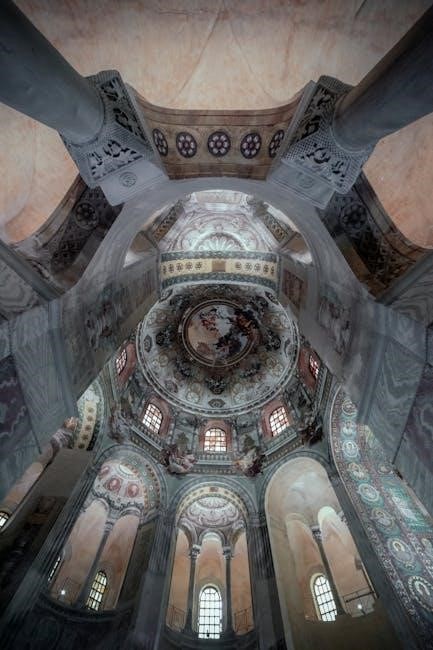
Archaic, Classical, and Hellenistic Periods
The Archaic period (c. 800–500 BC) saw the rise of rigid, symmetrical forms and early experimentation with sculpture. The Classical era (500–323 BC) emphasized harmony, balance, and the idealization of the human form, epitomized by the Golden Ratio. Transitioning to the Hellenistic period (323–31 BC), art became more dynamic, with dramatic compositions and emotional intensity, reflecting the cultural diversity of the Mediterranean world under Greek influence.
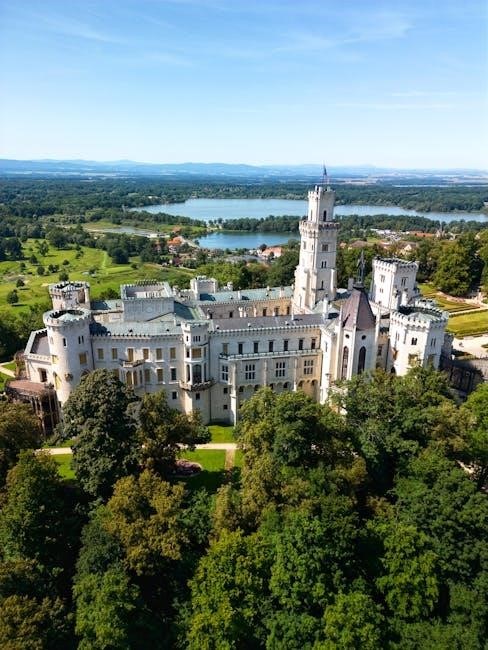
Major Sculptors and Painters
Classical Greek art is renowned for its legendary sculptors and painters who epitomized ideal beauty and harmony. Phidias, renowned for his iconic statues of Zeus and Athena, and Myron, celebrated for his “Discobolus,” exemplified the Classical period’s perfection. Polykleitos, known for his “Doryphoros,” defined proportional ideals. Painters like Apollodorus and Zeuxis pioneered techniques such as chiaroscuro, setting the foundation for future artistic movements. These masters left an indelible mark on the evolution of Western art.

Ancient Roman Art (300 BC – 500 AD)
Ancient Roman Art (300 BC – 500 AD) evolved from Greek influences, emphasizing grandeur and functionality. Notable works include the Pantheon and Colosseum, showcasing engineering prowess and architectural innovation.
Evolution from Greek Influence to Roman Style
Roman art emerged as a blend of Greek aesthetics and local traditions, transitioning from idealized forms to more realistic and functional designs. Early Roman art borrowed heavily from Greek sculpture and architecture, but over time, it developed a distinct identity. Notable works include the Pantheon and Roman portraiture, showcasing a shift toward practicality and grandeur. This evolution reflects Rome’s growing political and cultural influence, adapting Greek ideals to serve their Empire’s needs while fostering innovation in art and architecture.
Notable Works and Architects
Ancient Roman art is renowned for its monumental structures, such as the Colosseum and the Pantheon, showcasing advanced engineering and architectural innovation. The Romans developed aqueducts, roads, and public buildings, reflecting their emphasis on functionality and grandeur. Key architects like Vitruvius and Apollodorus of Damascus influenced Roman design, blending practicality with aesthetic appeal. These works highlight the Romans’ mastery of concrete and their ability to create enduring landmarks that symbolized their power and cultural identity.
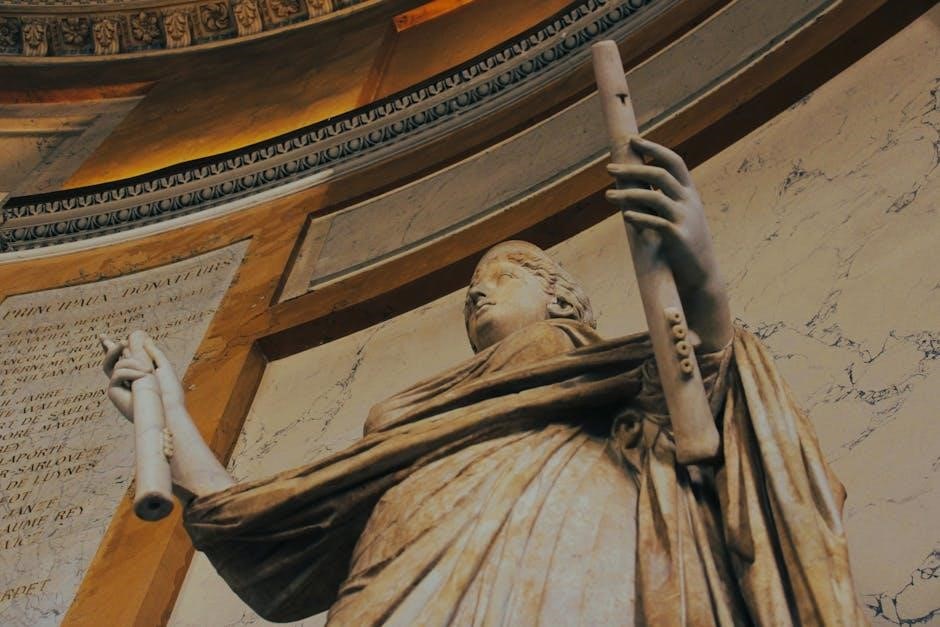
Byzantine Art (300 – 1453 AD)
Byzantine Art (300–1453 AD) is renowned for its stunning mosaics, religious themes, and blending of Eastern and Western styles. Characterized by golden mosaics and sacred subjects, it influenced early Renaissance art and preserved classical culture.
Characteristics of Byzantine Style
Byzantine art is renowned for its religious focus, ornate mosaics, and golden backgrounds, creating a divine and awe-inspiring atmosphere. It emphasizes symbolism and spiritual themes, often depicting religious figures with halos and formal poses. The style blends Eastern and Western influences, with intricate details and geometric patterns. Mosaics became a hallmark, using small tiles to create vivid, luminous scenes. This art form reflects the fusion of religious devotion and cultural richness, capturing the essence of the Byzantine Empire’s heritage.
- Mosaics with gold backgrounds
- Religious and symbolic imagery
- Formal and spiritual compositions
- Eastern and Western stylistic influences
Major Mosaics and Religious Art
Byzantine art is renowned for its intricate mosaics, often depicting religious themes. These works, adorned with gold leaf, symbolized divine light and spiritual themes. Iconic examples include the mosaics of Hagia Sophia, which blend religious and imperial imagery. Similarly, the churches of Ravenna showcase masterpieces like the Baptistry of the Arians, highlighting the enduring influence of Byzantine religious art. These mosaics remain pivotal in understanding the spiritual and artistic legacy of the Byzantine era.
Gothic Art (12th – 14th Century)
Gothic Art emerged in the 12th to 14th centuries, characterized by pointed arches, ribbed vaults, and flying buttresses, enabling taller structures. It emphasized light and intricate detailing.
Transition from Romanesque to Gothic
The shift from Romanesque to Gothic art marked a significant evolution in architectural and artistic styles. Romanesque structures, characterized by rounded arches and solid forms, gave way to Gothic innovations like pointed arches and ribbed vaults, enabling taller, more intricate buildings. This period also saw the rise of flying buttresses, allowing larger windows and the proliferation of stained glass. Sculpture became more naturalistic, and religious themes dominated, with elaborate carvings and ornate decorations reflecting a heightened sense of spirituality and grandeur.
Cathedrals and Stained Glass
Gothic art is prominently represented by the construction of grand cathedrals, such as Notre-Dame de Paris and Chartres Cathedral. These structures showcased soaring vaults and ribbed arches, symbolizing divine aspiration. Stained glass became a central feature, depicting religious narratives in vivid colors. The intricate designs and light filtration created a mystical atmosphere, emphasizing theological themes. This period marked a pinnacle in engineering and artistic expression, blending spirituality with architectural innovation.
Early Renaissance (14th – 15th Century)
Revival of Classical Influence
The Early Renaissance saw a revival of classical ideals, with artists like Giotto and Brunelleschi exploring perspective and humanism, setting the stage for later mastery.
The Early Renaissance saw a resurgence of interest in classical Greek and Roman art, inspiring artists to study ancient forms and techniques. Figures like Giotto, Brunelleschi, and Masaccio pioneered this shift, blending realism with timeless ideals. The period emphasized perspective, anatomy, and humanism, marking a departure from medieval styles. This revival laid the groundwork for the High Renaissance, fostering creativity and intellectual curiosity that defined the era.
Key Figures: Giotto, Brunelleschi, and Masaccio
Giotto, Brunelleschi, and Masaccio were pioneers of the Early Renaissance. Giotto revolutionized painting with emotional depth and naturalism, as seen in his frescoes. Brunelleschi, an architect and engineer, pioneered linear perspective. Masaccio introduced dramatic compositions and chiaroscuro, influencing later artists. Their innovative techniques laid the groundwork for the Renaissance, bridging medieval traditions with modern artistic expression.
High and Late Renaissance (16th Century)
The 16th century saw masterpieces by Leonardo, Michelangelo, and Raphael, marking the peak of Renaissance art with works like the Sistine Chapel and Mona Lisa.
Major Artists: Leonardo, Michelangelo, Raphael
Leonardo da Vinci, Michelangelo, and Raphael were towering figures of the High Renaissance. Leonardo’s Mona Lisa and The Last Supper showcased his mastery of sfumato and composition. Michelangelo’s Sistine Chapel ceiling and David highlighted his sculptural genius and fresco techniques. Raphael’s The School of Athens and portraits exemplified harmony and balance. Their works epitomized the Renaissance ideal of humanism, blending technical brilliance with emotional depth, leaving a lasting legacy in art history.
Iconic Works: Sistine Chapel, Mona Lisa
The Sistine Chapel’s ceiling, painted by Michelangelo, showcases breathtaking frescoes depicting biblical scenes with vibrant colors and intricate details. Leonardo da Vinci’s Mona Lisa captivates with its enigmatic smile, exemplifying Renaissance mastery. Both works symbolize artistic excellence, blending technique and emotion to create timeless masterpieces that define the High Renaissance.
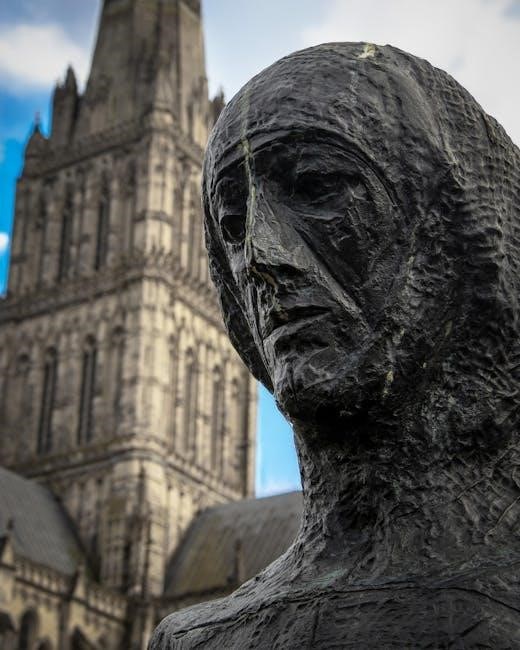
Baroque and Rococo Art (17th – 18th Century)
The Baroque style emphasized dramatic lighting and intense emotions, while Rococo art featured lighthearted themes and ornate details, contrasting the heavy grandeur of the earlier period.
Baroque: Drama and Movement
The Baroque period, spanning the 17th century, emphasized dramatic intensity and dynamic movement; Artists like Caravaggio and Rembrandt used chiaroscuro to create stark contrasts, evoking emotion and tension. Sculptors such as Gian Lorenzo Bernini crafted intricate, lifelike pieces that captured motion and energy. Architecture became grandiose, with ornate details and sweeping designs. This era celebrated dramatic storytelling and emotional depth, laying the groundwork for later artistic movements by pushing boundaries in technique and expression.
Rococo: Lightness and Ornamentation
Rococo art, flourishing in the 18th century, emphasizes lightness, delicacy, and ornamentation. Characterized by pastel colors, asymmetrical designs, and playful motifs, it often depicted nature and everyday life. Notable artists like Jean-Honoré Fragonard and François Boucher created works that reflected the era’s charm and elegance. This period marked a shift from the dramatic Baroque style, focusing instead on intimate, whimsical scenes that captured the spirit of the time.
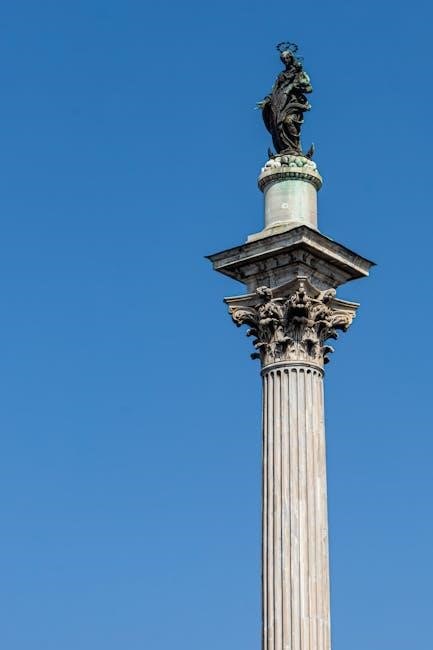
Neoclassical and Romanticism (18th – 19th Century)
Neoclassicism revived classical ideals, while Romanticism emphasized emotion and nature, reflecting shifting cultural values and artistic expression during this transformative period.
Neoclassical Revival
The Neoclassical Revival emerged in the 18th century, inspired by classical antiquity and Enlightenment values. It emphasized order, reason, and moral ideals, rejecting Baroque excess. Architects and artists sought to revive ancient Roman and Greek styles, featuring symmetry, clean lines, and classical motifs. Influenced by figures like Winckelmann, the movement reshaped art and architecture, producing iconic works such as the Panthéon in Paris and the White House in Washington, D.C., reflecting a return to timeless classical ideals.
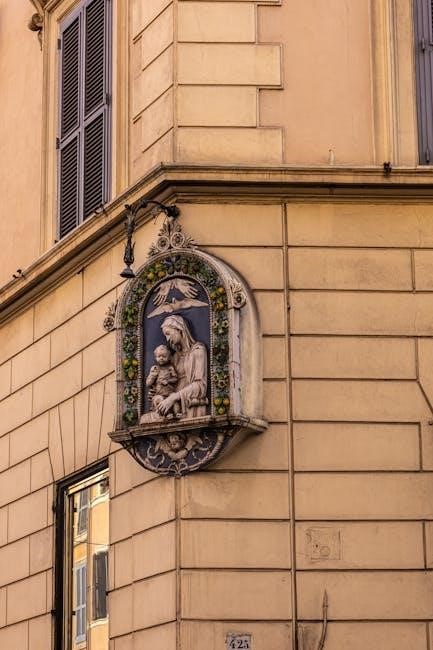
Romanticism: Emotion and Nature
Romanticism emerged in the late 18th to early 19th century, emphasizing emotion, individualism, and the power of nature. It was a reaction against Neoclassical order and industrialization. Artists turned to dramatic landscapes, strong emotions, and sometimes the supernatural. This movement celebrated the sublime, the irrational, and the personal experience. Key figures include J.M.W. Turner and Caspar David Friedrich, whose works captured the awe-inspiring aspects of nature and the human spirit, often using light and color to evoke profound emotional responses.
Modern Art ( Late 19th – 20th Century)
Modern Art emerged in the late 19th to 20th century, characterized by movements like Impressionism, Expressionism, Cubism, Surrealism, and Abstract art.
Impressionism and Expressionism
Impressionism emerged in the late 19th century, focusing on capturing light and color in outdoor settings. Artists like Claude Monet and Pierre-Auguste Renoir emphasized fleeting moments and natural beauty. Expressionism, developing in the early 20th century, prioritized emotional intensity over realism. Artists such as Vincent van Gogh and Edvard Munch used distorted forms and vibrant colors to convey inner experiences. Both movements broke from traditional techniques, paving the way for modern art’s diversity and innovation.
Major Movements: Cubism, Surrealism, Abstract
Cubism, pioneered by Picasso and Braque, broke from realism, emphasizing geometric forms. Surrealism, led by Dalí and Miró, explored the subconscious through fantastical imagery. Abstract art, with pioneers like Kandinsky, focused on non-representational forms, prioritizing emotion and color over realism. These movements revolutionized modern art, pushing boundaries and redefining creative expression in the 20th century.
Contemporary Art ( Late 20th Century – Present)
Contemporary Art explores globalization and diverse styles, incorporating digital and multimedia techniques. Artists like Banksy and Takashi Murakami continuously push creative boundaries.
Globalization and Diverse Styles
Contemporary art reflects globalization, blending cultures and styles worldwide. Digital art, street art, and mixed media have emerged, fostering diversity. Artists like Yayoi Kusama and Banksy exemplify this era’s inclusivity, pushing boundaries and challenging traditions. Globalization has democratized art, allowing voices from all regions to be heard, creating a rich, dynamic tapestry of creative expression.
Key Artists and Trends
Contemporary art is shaped by diverse global voices, with artists like Banksy, Ai Weiwei, and Gerhard Richter pushing boundaries. Digital art, street art, and installations have gained prominence, reflecting societal changes. Globalization has blurred cultural lines, fostering hybrid styles. Themes like identity, technology, and sustainability dominate, while artists experiment with new mediums, challenging traditional norms. This era emphasizes creativity’s democracy, where art is accessible and ever-evolving, mirroring the dynamic world we live in.
The art history timeline is a vital resource for understanding the evolution of artistic expression, offering insights into cultural, historical, and creative developments across millennia.
Significance of the Art Timeline
The art timeline is a vital tool for understanding the progression of artistic movements and their cultural contexts. It connects historical events with creative developments, offering insights into how societies expressed their values and beliefs. By tracing the evolution of art, the timeline reveals recurring themes, influences, and innovations. It serves as an essential resource for students, researchers, and enthusiasts, fostering appreciation for the diversity and richness of global artistic heritage. This structured overview is indispensable for studying the history of art in depth.
Resources for Further Study
Downloadable PDF guides like the A.P. Art History Simplified Timeline and Art History Timeline through 1900 offer detailed overviews of major periods and styles. These resources include timelines, significant movements, and notable artists, spanning from prehistoric art to modern times. They are ideal for students and educators seeking a structured approach to understanding art history. Printable versions are available for classroom use, providing a handy reference for comprehensive study.